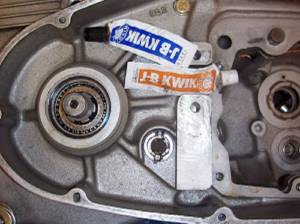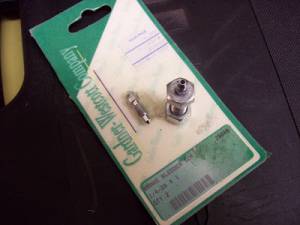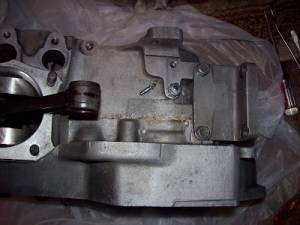Table of Contents
This is an old revision of the document!
IH: Oiling & Lubrication - Sub-01U
Plugging the Transfer Valve
Plug it or Not?
There are many debates over the actual function of the transfer valve as well as plugging it.
If you plug it, theoretically no more oil should enter the primary due to sit sumping. Read more on Sit Sumping in the Sportsterpedia.
Normally, if the bike does wet sump, excess oil will trickle into the primary case. 1)
When you start the engine, the return oil system will gradually empty the contents of the crank cases back to the tank.
It will also shoot excess oil out through the gear case breather onto your clean floor.
Once the excess oil is removed from the crank cases it will start drawing oil in through the transfer valve until the oil level is returned to it's correct level.
At that point, your oil tank should have returned to it's correct level and the engine should be running normally.
The transfer valve also allows oil to flow from the primary back into the crankcase if the sprocket shaft seal was leaking.
2)
Excess oil gets into the primary through a bad crank seal or poor sealing of the oil pump.
Keep in mind that drain oil from the top end also comes down the pushrod tubes and settles in the gearcase and down the holes in the cylinders into the crankcase.
Any oil that gets in the gearcase floods the oil pump scavenge inlet and runs back into the crankcase oil slot.
But, the oil was originally in the tank when the engine was shut off last.
It gets to the crankcase thru normal top end drainage, the check valve or oil seal issues in the oil pump, flooding the oil trap, then to the crankcase, up the wall and into the primary thru the transfer valve.
So plugging the transfer valve only addresses issues with oil getting into the primary from the crankcase but doesn't address excess oil getting into the crankcase.
These are separate and equally important issues.
Main reasons for plugging the transfer valve:
- To stop oil from filling the primary compartment when the engine sits for a while.
- To enable you to run separate oils in the primary and the engine without cross contamination. 3)
- To run the primary dry. People do that to run belts (even though it's not necessary). 4)
So there is technically no need to have the transfer function to remove sumped oil from the primary.
However, if the crank seal blows out, you'll end up with a primary full of oil and lower oil flow to the engine due to half of the oil being in the primary.
But that's a separate issue you'd have to fix with or without the transfer valve functioning.
Quote from thefrenchowl of the XLFORUM 5)
H-D called this an “oil transfer valve” from its 1st application on the K model where indeed it acted as a suck valve for excess oil in the tranny due to a poor oil seal design on the engine sprocket. It had a tube attached to it, bent down towards the bottom of the sprocket. When oil level was normal in the tranny, it just sucked air. When the oil level went up, it submerged the tube and the vacuum in the crank cases sucked out the excess in the crank cases. The bad sealing idea was discarded in '54 and replaced with a proper lip seal and our unloved transfer valve. The guy who designed it is an unsung genius, cause it's real purpose, intended or not, wasn't discovered until the factory got rid of it in the late 70s. That's when they noticed that bikes which did not see constant use got various amounts of rust building up in the tranny, despite it having the small hole breather in the filler alloy cap and a special vent bolt installed on top of the tranny. A new problem they never experienced in the past engines. They then discovered there was little air circulation despite the 2 vents in these trannies and moisture stayed in to do the damage. In earlier engines, air is constantly being replaced in the tranny by the one way valve/crankcase vacuum and moisture can escape. So, if you use your bike daily, by all means, discard (the transfer valve). Personnally, I think it's a great idea and never experienced its failure in all the years I've been riding Iron Sporties or Ks, nearly 30 years now. If a part is in there, it's got a purpose. I've had too much oil in the tranny as anybody has experienced, but it's always been a seal failure, nothing to do with the transfer valve.
Removing the Transfer Valve
See Removing / Installing the Transfer Valve in the Sportsterpedia.
Plugging the Valve / Hole
When plugging the transfer valve;
With the dual function of moving excess oil leakage from sit sumping and venting primary compartment air, consensus says to also install a primary vent as well.
See Venting the Primary below.
Options for plugging the vent/hole:
- Epoxy the valve.
- Using JB Weld to plug the hole in the transfer valve has been done by many with good results.
However, the valve needs to be cleaned of all oil and debris first or it can lose it's adherence, travel, and find it's way into the crankcase.
It's best to remove the transfer valve before plugging it so you don't accidently get anything in the crankcase.
The valve can be removed with a square drive pipe plug that sits flush with left hand crankcase side. 6)
Pop out the screen, (you wont need it) and the hole is behind it. Clean and dry the hole and plug it with JB Weld or something similar. 7)
- Weld the hole in the valve.
- If you can access a welder, you can weld the hole in the valve shut (removed first). 8)
- Plug the valve.
- You can drill & tap the hole in the valve to accept either an #8-32 or #10-32 soft brass screw and thread that screw in there all slathered in red Loctite.
Once it's in there, distort the screw's head by peening it with a small punch so it can't back out. 9)
- Plug the case.
- HD made a plug (24571-72r) for the transfer hole used on XR-750. 10)
- You can remove the transfer valve and make a dummy threaded plug to replace it. The threads are 3/4“-16.
- You could split the cases, remove / discard the transfer valve and drill and tap the hole for a bolt.
| The transfer below valve below was packed with JB Weld to negate it's operation. 11) | |
 |  |
Venting the Primary
With the transfer valve plugged, the primary can't breath as it can with the transfer valve functioning.
That air path would now be blocked.
Technically, the primary has a vent other than the transfer valve being the clearance in the clutch cable where it enters the primary.
That can also act as a vent as air can enter and escape there (the part where the actual cable goes into the threaded piece that screws into the clutch cable hole). 12) 13)
There is slack (slop) where the cable end is pressure fitted ( by slack adjustment of cable) into the threaded piece.
There is air space open along the cables path through the threaded piece also.
This would give you a vent of sorts as this is not sealed up and pressure would escape at this point.
Installing a dedicated primary vent:
- You can drill a tiny hole in the primary access plug.
- You can install a vent plug (like the 34744-77 tranny vent) through one of the holes on top of the cases, just in front of the rear engine mount bracket.
Those two bolt holes are used for the oil tank bracket (xlch model) or battery carrier bracket (xlh model). 14)
'77-up ironheads have this 3/4”x16 vent fitting factory installed in this location (transfer valve deleted in '77)
Short frame cases use 4 bolts and 3 studs to hold the rear mount to the cases. 15) Long frame cases use 2 bolts and 3 studs.
On long frame cases the front two bolts were dropped to make room for the electric leg.
The XLH battery box / oil bracket was bolted in the vacated area. This is where the vent bolt for 77> was positioned.
These bracket bolts are in a position where trans oil don't seem to get tossed as much. So they don't eject much oil.
All 76< long frame cases (except 71XLCH) will accept the vent bolt in the 77> position. Bolt goes in the hole closest to the case parting seam.
Conversely, installing the vent bolt in any of the four short frame rear mount bolt holes usually results in drips from the vent. - On <69 engines, you can drill and tap a hole at the top of the case on the primary side and tee into the vent line going to the oil tank. 16)
The vent below was made with a bolt with a hole drilled through the center of it. That hole was counter-bored 7/32“ on top and tapped 1/4”-28 to fit a brake bleeder screw.
The bottom half of the bleeder valve was cut off to make it fit the hole better and to hold the battery stand mount down.
A small hose was slid over the bleeder screw routed down.


